- Twenty-two billion-dollar weather disasters affected the U.S. in 2020.
- This crushed the previous record number of such disasters in any year since 1980.
- Among these were hurricanes Laura and Isaias, and the August Midwest derecho.
Twenty-two separate billion-dollar weather disasters impacted the United States in 2020, by far a record number of such events in any year, according to a report released Friday by NOAA.
The 22 disasters with damage estimates of at least $1 billion obliterated the previous record number in any year, 16 in both 2011 and 2017, in NOAA records since 1980.
All but two of the disasters occurred east of the Rockies, including seven hurricanes and tropical storms, and 13 separate severe weather events.
Only the record-breaking wildfire season and the expansive drought made the billion-dollar list out of the West in 2020.
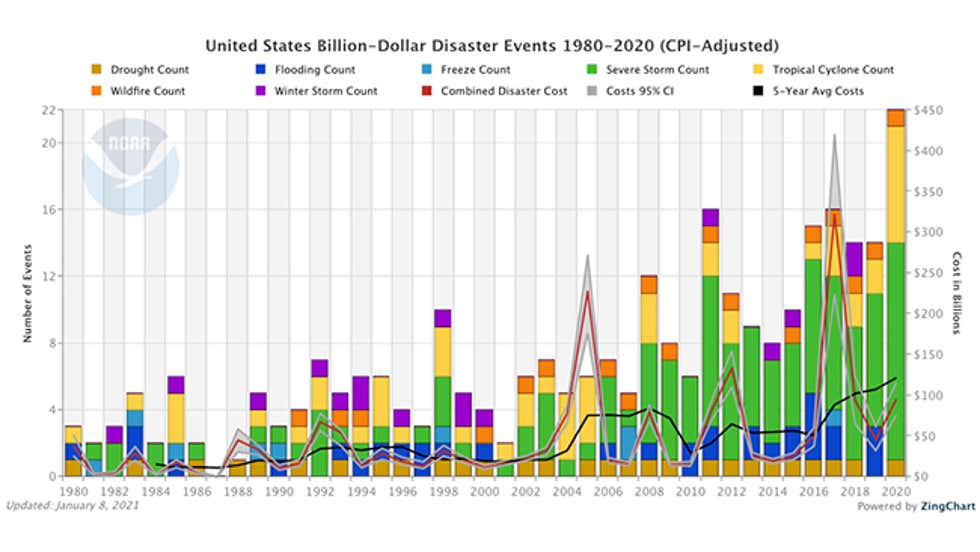
The yearly count of billion-dollar weather disasters in the U.S. since 1980, adjusted for inflation. 2020 set a new record for the most such disasters in any year.
(NOAA/NCEI)
The costliest 2020 disasters included Hurricane Laura ($19 billion), the Western wildfires ($16.5 billion) and the massive Midwest derecho ($11 billion).
The derecho, a widespread, destructive thunderstorm complex that raced 770 miles across the Midwest on Aug. 10, was the costliest single-day severe thunderstorm event to strike the U.S. since 1980.
Of the 128 severe thunderstorm events in NOAA's billion-dollar database, only the April 2011 Super Outbreak ($12.1 billion) – a multi-day outbreak of over 300 tornadoes, including 15 rated EF4 or EF5 – was more costly than the 2020 Midwest derecho.
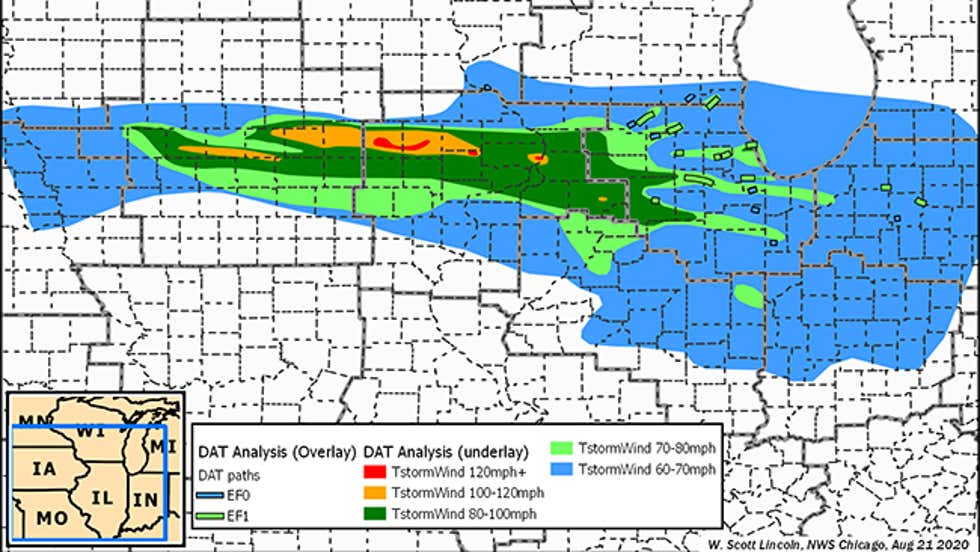
Analysis of estimated wind speeds in the August 10, 2020, Midwest derecho.
(NOAA/NWS/Scott Lincoln)
It was the sixth straight year with 10 or more billion-dollar disasters.
The total damage from these 22 events in 2020 – $95 billion – ranked fourth-highest in any year since 1980, behind only 2017 ($321.8 billion), 2005 ($227.6 billion) and 2012 ($133.3 billion).
Each of those costlier seasons included at least one, if not multiple, catastrophic hurricane strikes over highly-populated areas of the U.S.
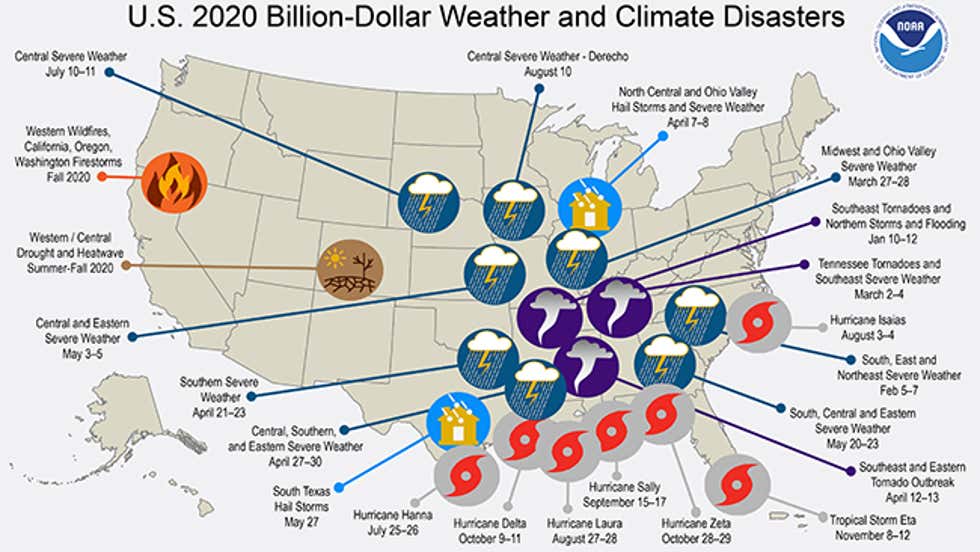
Map and approximate locations of the 22 separate billion-dollar weather disasters in the U.S. in 2020.
(NOAA/NCEI)
Including adjustments for inflation, 285 U.S. weather and climate disasters have tallied overall damage costs that reached or exceeded $1 billion, with a total damage toll of at least $1.875 trillion.
Severe thunderstorm events have been the most frequent billion-dollar disaster, comprising 45% of all events since 1980.
However, the 52 tropical storm and hurricane events since 1980 account for almost $1 trillion in damage, or 53% of the total damage toll.
Billion-Dollar Weather Disasters of 2020
Jan. 10-12: Southeast tornadoes and Northern storms and flooding ($1.2 billion, 10 killed)
Feb. 5-7: South, East and Northeast severe weather ($1.4 billion, 3 killed)
March 2-4: Tennessee tornadoes and Southeast severe weather ($2.5 billion, 25 killed)
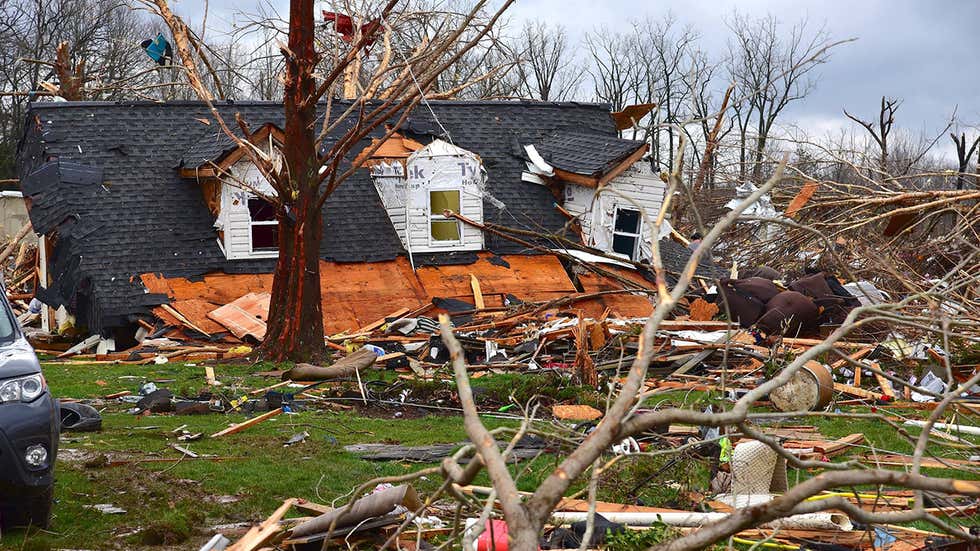
A tornado-damaged home is seen destroyed in Cookeville, Tennessee, on Tuesday, March 3, 2020.
(Jack McNeely/Cookeville Herald-Citizen)
March 27-28: Midwest and Ohio Valley severe weather ($2.6 billion)
April 7-8: North Central and Ohio Valley hailstorms and severe weather ($2.9 billion)
April 12-13: Southeast, Eastern holiday tornado outbreak ($3.6 billion, 35 killed)
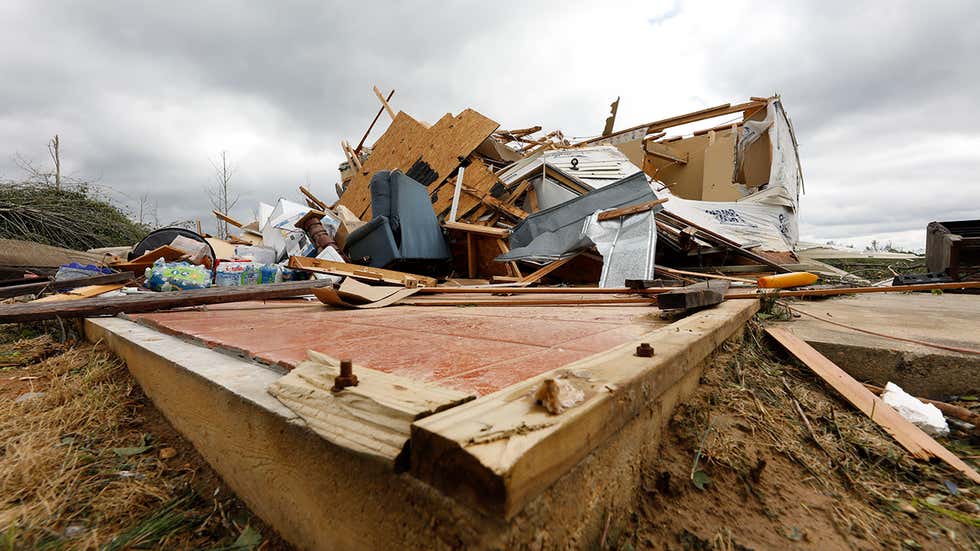
An exposed foundation shows how powerful the winds were from a tornado that tore through this Bassfield, Mississippi, neighborhood, Monday, April 13, 2020.
(AP Photo/Rogelio V. Solis)
April 21-23: Southern severe weather ($1.4 billion, 3 killed)
April 27-30: Central, Southern and Eastern severe weather ($1 billion, 1 killed)
May 3-5: Central and Eastern severe weather ($2.1 billion, 2 killed)
May 20-23: South, Central and Eastern severe weather ($1.6 billion, 2 killed)
May 27: South Texas hailstorms ($1.4 billion)
Summer and beyond: Western, Central drought, heat ($4.5 billion, 45 killed)
July 10-11: Central severe weather ($1.2 billion)
July 25-26: Hurricane Hanna – Texas Coast, Rio Grande Valley ($1.1 billion)
Summer and fall: Western wildfires ($16.5 billion; 46 killed)
Aug. 3-4: Hurricane Isaias – East Coast ($4.8 billion; 16 killed)
Aug. 10: Midwest derecho ($11 billion; 4 killed)
Aug. 27-28: Hurricane Laura – Louisiana and neighboring states ($19 billion; 42 killed)
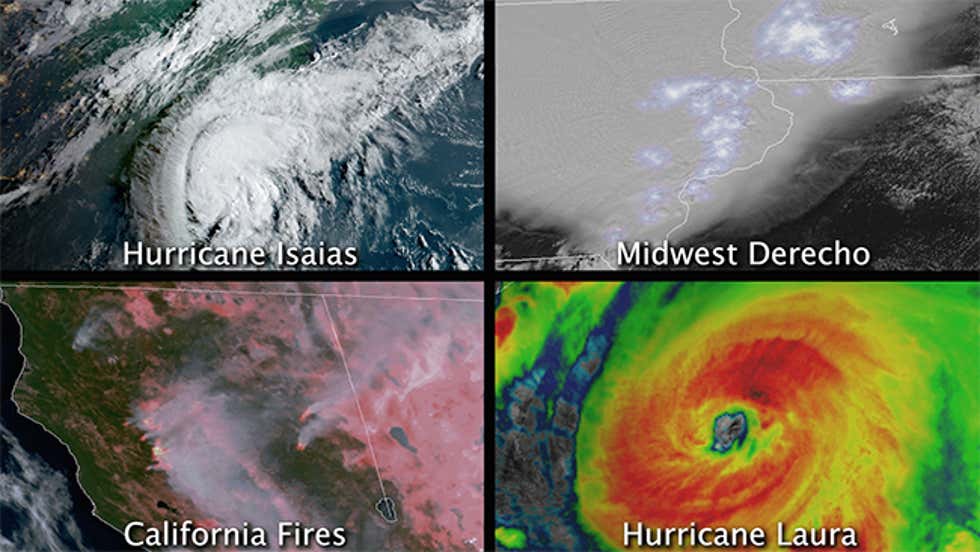
Four billion-dollar weather disasters of August 2020, according to NOAA.
(NOAA)
Sept. 15-17: Hurricane Sally – mainly in Alabama, Florida, Georgia ($7.3 billion, 5 killed)
Oct. 9-11: Hurricane Delta – Louisiana and neighboring states ($2.9 billion, 5 killed)
Oct. 28-29: Hurricane Zeta – Southeast ($3.5 billion, 6 killed)
Nov. 8-12: Tropical Storm Eta – Southeast ($1.5 billion, 12 killed)
The Weather Company’s primary journalistic mission is to report on breaking weather news, the environment and the importance of science to our lives. This story does not necessarily represent the position of our parent company, IBM.
By Jonathan Erdman and Chris Dolce January 08, 2021
https://weather.com/storms/severe/news/2021-01-08-record-billion-dollar-us-weather-disasters-2020-noaa
For more information, contact us at 713-515-5774 or 713-858-8113
Posted Thursday, February 04 2021 1:00 PM
Tags : Severe Weather, Insurance Claims, Property Damage, Weather Channel, NOAA, Hartgrove Insurance, TWFG, Record 22 Billion-Dollar Weather Disasters Struck the U.S. in 2020, NOAA, houston, meyerland, bellaire, westbury, sugarland, pearland, katy, cypress, fort bend, montgomery, missouri city, friendswood, stafford, fresno, galveston, spring, brazoria, rosharon, kingwood
|